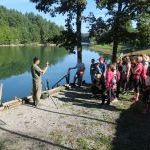The Network of Schools of Škocjan Caves Regional Park
The Škocjan Caves and their surroundings are important on national level (protected area) and international level (World Heritage Site UNESCO, Ramsar, MAB). The heritage of Škocjan Caves Regional Park is the bridge between the past, present and the future. To preserve this knowledge, The Network of Schools of Škocjan Caves Regional Park started in the 2003. Pupils from the school are connected with the Škocjan Caves Regional Park in the various ways from an early age. The goal of The Network is to inform the children about the values of Škocjan Caves Regional Park in a friendly and creative way.
Website
Škocjan Caves Regional Park website
Useful links
The UK's National Parks offer teaching resources and learning opportunities for schools
Country
Media
Photos: Kranjc D., Šturm S., Zorman T.
* TOP TIP *
'Visit a local nature reserve near you and find out about why natural habitats are important for plant and animal diversity'
How is the project linked to climate change and sustainability?
Children from a very early age learn how to observe nature and its connectivity to understand that all actions have consequences. They learn about natural habitats in Park Škocjan Caves, about river Reka, which flows through Škocjan caves, about animal and plant species which live there, about climate changes and the pollution. The Regional Park Škocjan Caves is part of many projects which are dedicated to climate changes, biodiversity, and sustainable use of resources in this area. In all these projects they also involve a network of schools. Regional Park Škocjan Caves sets an example for sustainable tourism, sustainable treatment of resources and inhabitants, as well as the importance of cultural heritage.
Who is involved?
Teachers from primary and secondary schools; school pupils and university students; local inhabitants, museums and research institutions; government ministries and associations connected with nature preservation and protected areas in Europe.
How are the participants involved?
Pupils visit the Park Škocjan Caves (PŠC) on excursions and learn about wildlife in caves, characteristics, history of caves and Škocjan caves, about Karst, wetlands, UNESCO heritage, cultural heritage, and archeology. They also observe the weather (within a project CLIMAPARKS) and learn about biodiversity, sustainability and about the sources of water. Mentors of Network of Schools of Park Škocjan Caves (NSPŠC) have regular meetings with Park Škocjan Caves staff. At the beginning of the school year they set the working programme, they discuss what they want to see, which projects they want to take part, in and the lecturers or topics they want to study. NSPŠC takes their mentors to other countries to see good practices and invites reputed lecturers to talk about topics of interest. Some ministries cooperate with support, associations and universities cooperate with their knowledge.
Key steps:
Although this is a network of schools, the model is easily transferable to other schools in protected areas. It can easily be a project of only one school, which can create a module about their protected area and start exploring it – from natural to cultural heritage to sustainability. Here are some areas to consider:
- Is your school in the protected area or nearby protected natural site?
- Would you like to explore this protected area/protected natural site with your pupils? If so, form a course and involve the children.
- Think about the content of the course and ask children to cooperate – set the content and the working plan.
- Promote your idea and invite your colleagues - they can be also from other schools, it is easier to work in a group.
- Is there any institution who takes care off this protected area? Can you connect with it? They can help you with different learning/teaching materials and perhaps offer talks, so you will always have the best knowledge.
- Put your course on the school website, describe it so that the others and parents can see it, you may need them in the future.
- Present your work to the public and parents at the end of a year – you may attract some new children and mentors for the next year.
- Don’t forget to invite the journalists as well to promote your work

